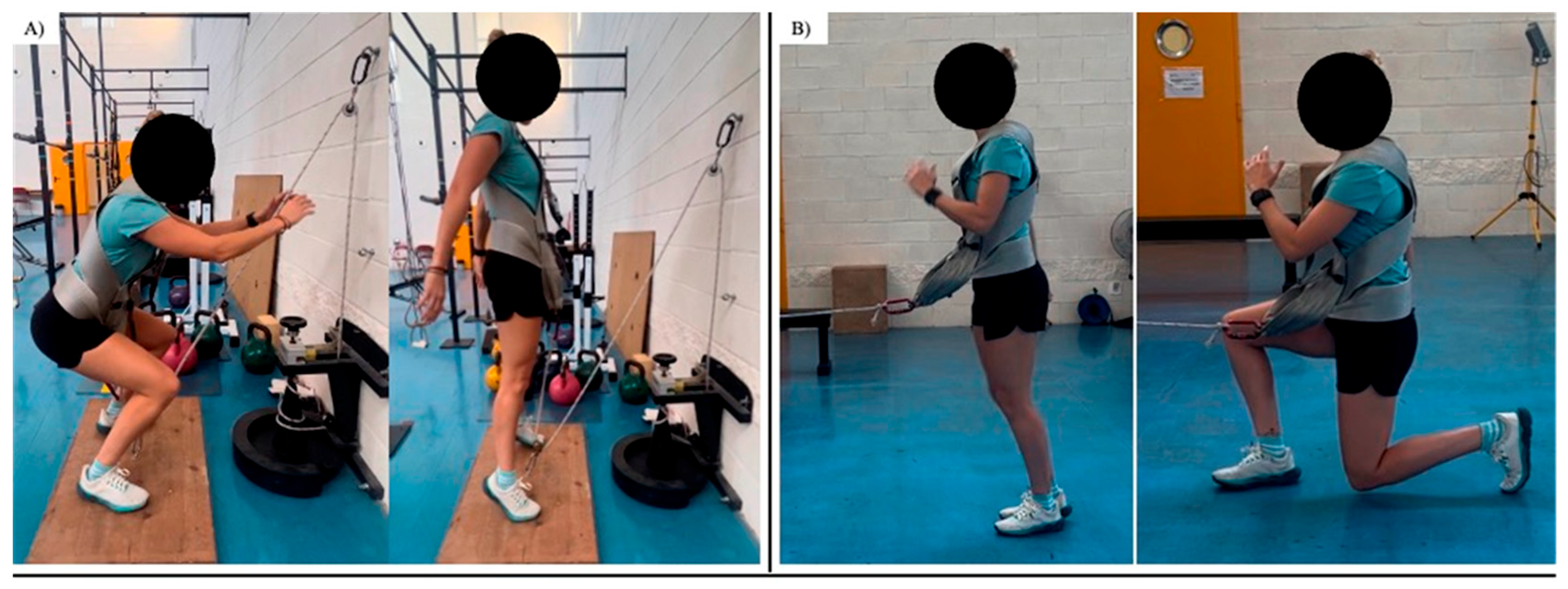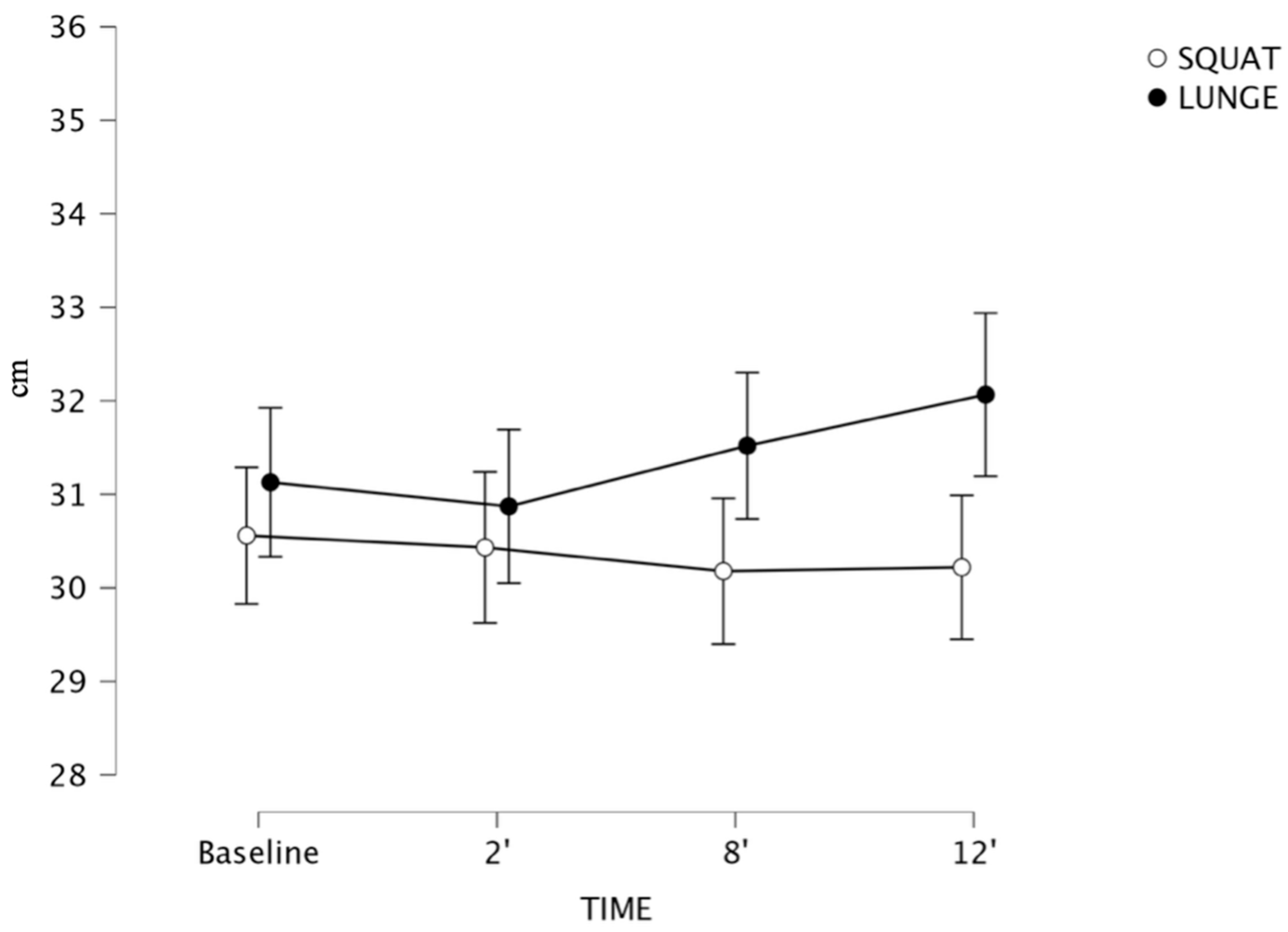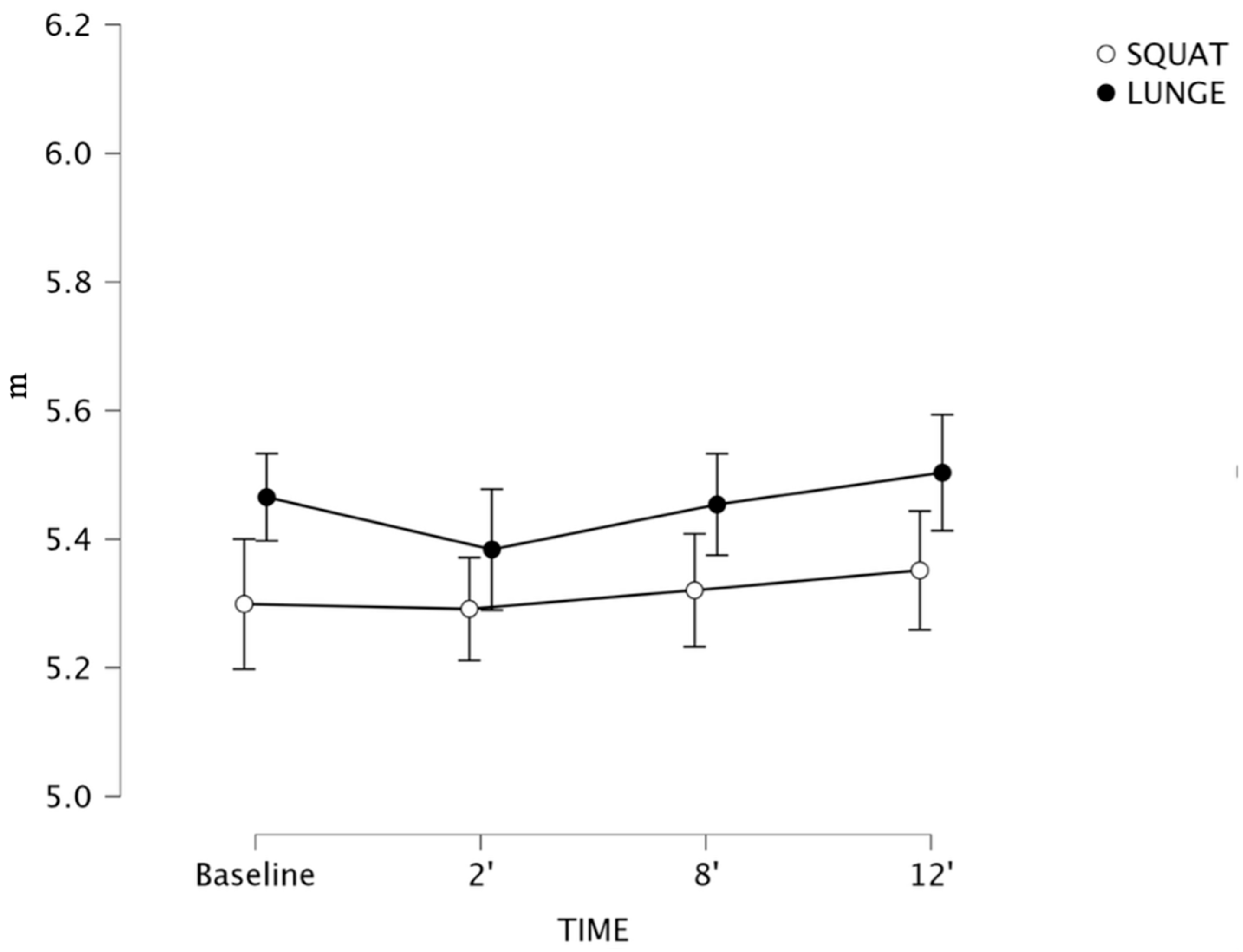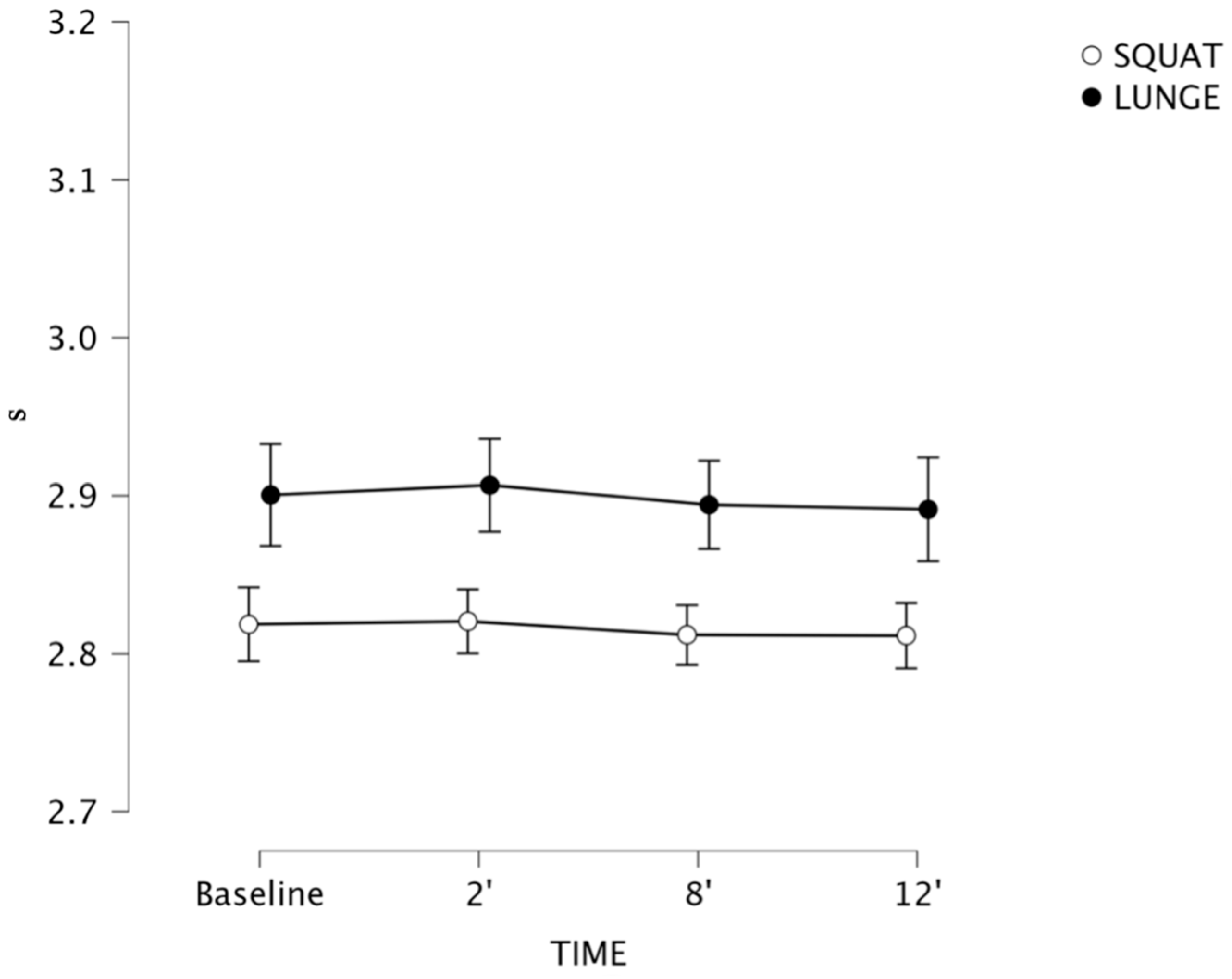PAPE Effect in Female Footballers: Analyzing the Benefits of Different Flywheel Protocols
Abstract
1. Introduction
2. Materials and Methods
2.1. Participants and Sample Size Estimation
2.2. Study Design
2.3. Procedures
2.4. Intervention
2.5. Statistical Analyses
3. Results
4. Discussion
Limitations and Future Directions
5. Conclusions
6. Practical Applications
Author Contributions
Funding
Institutional Review Board Statement
Informed Consent Statement
Data Availability Statement
Acknowledgments
Conflicts of Interest
References
- Sygulla, K.S.; Fountaine, C.J. Acute post-activation potentiation effects in NCAA Division II female athletes. Int. J. Exerc. Sci. 2014, 7, 212–219. [Google Scholar] [CrossRef] [PubMed]
- Boullosa, D.; Del Rosso, S.; Behm, D.G.; Foster, C. Post-activation potentiation (PAP) in endurance sports: A review. Eur. J. Sport Sci. 2018, 18, 595–610. [Google Scholar] [CrossRef]
- Cuenca-Fernández, F.; Smith, I.C.; Jordan, M.J.; MacIntosh, B.R.; López-Contreras, G.; Arellano, R.; Herzog, W. Nonlocalized postactivation performance enhancement (PAPE) effects in trained athletes: A pilot study. Appl. Physiol. Nutr. Metab. 2017, 42, 1122–1125. [Google Scholar] [CrossRef]
- Boullosa, D.; Beato, M.; Iacono, A.D.; Cuenca-Fernández, F.; Doma, K.; Schumann, M.; Behm, D.G. A new taxonomy for postactivation potentiation in sport. Int. J. Sports Physiol. Perform. 2020, 15, 1197–1200. [Google Scholar] [CrossRef] [PubMed]
- Trybulski, R.; Makar, P.; Alexe, D.I.; Stanciu, S.; Piwowar, R.; Wilk, M.; Krzysztofik, M. Post-activation performance enhancement: Save time with active intra-complex recovery intervals. Front. Physiol. 2022, 13, 840722. [Google Scholar] [CrossRef]
- Maroto-Izquierdo, S.; Bautista, I.; Rivera, F. Post-activation performance enhancement (PAPE) after a single-bout of high-intensity flywheel resistance training. Biol. Sport 2020, 37, 343–350. [Google Scholar] [CrossRef]
- Chiu, L.Z.; Fry, A.C.; Weiss, L.W.; Schilling, B.K.; Brown, L.E.; Smith, S.L. Postactivation potentiation response in athletic and recreationally trained individuals. J. Strength Cond. Res. 2003, 17, 671–677. [Google Scholar]
- Guo, W.; Liang, M.; Lin, J.; Zhou, R.; Zhao, N.; Aidar, F.J.; Badicu, G. Time duration of post-activation performance enhancement (PAPE) in elite male sprinters with different strength levels. Children 2022, 10, 53. [Google Scholar] [CrossRef]
- Beato, M.; Madruga-Parera, M.; Piqueras-Sanchiz, F.; Moreno-Pérez, V.; Romero-Rodriguez, D. Acute effect of eccentric overload exercises on change of direction performance and lower-limb muscle contractile function. J. Strength Cond. Res. 2021, 35, 3327–3333. [Google Scholar] [CrossRef]
- Beato, M.; de Keijzer, K.L.; Muñoz-Lopez, A.; Raya-González, J.; Pozzo, M.; Alkner, B.A.; Iacono, A.D.; Vicens-Bordas, J.; Coratella, G.; Maroto-Izquierdo, S.; et al. Current guidelines for the implementation of flywheel resistance training technology in sports: A consensus statement. Sports Med. 2024, 54, 541–556. [Google Scholar] [CrossRef] [PubMed]
- Krzysztofik, M.; Trybulski, R.; Trąbka, B.; Perenc, D.; Łuszcz, K.; Zajac, A.; Alexe, D.I.; Dobrescu, T.; Moraru, C.E. The impact of resistance exercise range of motion on the magnitude of upper-body post-activation performance enhancement. BMC Sports Sci. Med. Rehabil. 2022, 14, 123. [Google Scholar] [CrossRef] [PubMed]
- Gołaś, A.; Maszczyk, A.; Zajac, A.; Mikołajec, K.; Stastny, P. Optimizing post activation potentiation for explosive activities in competitive sports. J. Hum. Kinet. 2016, 52, 95–106. [Google Scholar] [CrossRef]
- Asencio, P.; García-Valverde, A.; Albaladejo-García, C.; Beato, M.; Moreno, F.J.; Sabido, R. Analysis of concentric and eccentric power in flywheel exercises depending on the subjects’ strength level and body mass. J. Strength Cond. Res. 2024, 38, 1394–1400. [Google Scholar] [CrossRef]
- de Keijzer, K.L.; McErlain-Naylor, S.A.; Iacono, A.D.; Beato, M. Effect of volume on eccentric overload–induced postactivation potentiation of jumps. Int. J. Sports Physiol. Perform. 2020, 15, 976–981. [Google Scholar] [CrossRef]
- Beato, M.; Bigby, A.E.; De Keijzer, K.L.; Nakamura, F.Y.; Coratella, G.; McErlain-Naylor, S.A. Post-activation potentiation effect of eccentric overload and traditional weightlifting exercise on jumping and sprinting performance in male athletes. PLoS ONE 2019, 14, e0222466. [Google Scholar] [CrossRef]
- de Hoyo, M.; Pradas, F.; Sañudo, B.; Carrasco, L. Effects of eccentric overload bout on change of direction and performance in soccer players. Int. J. Sports Med. 2014, 35, 741–748. [Google Scholar] [CrossRef] [PubMed]
- Timon, R.; Allemano, S.; Camacho-Cardeñosa, M.; Camacho-Cardeñosa, A.; Martinez-Guardado, I.; Olcina, G. Post-activation potentiation on squat jump following two different protocols: Traditional vs. inertial flywheel. J. Hum. Kinet. 2019, 69, 271–281. [Google Scholar] [CrossRef]
- Beato, M.; McErlain-Naylor, S.A.; Halperin, I.; Iacono, A.D. Current evidence and practical applications of flywheel eccentric overload exercises as postactivation potentiation protocols: A brief review. Int. J. Sports Physiol. Perform. 2020, 15, 154–161. [Google Scholar] [CrossRef] [PubMed]
- de Keijzer, K.L.; Gonzalez, J.R.; Beato, M. The effect of flywheel training on strength and physical capacities in sporting and healthy populations: An umbrella review. PLoS ONE 2022, 17, e0264375. [Google Scholar] [CrossRef]
- Fu, K.; Chen, L.; Poon, E.T.C.; Wang, R.; Li, Q.; Liu, H.; Ho, I.M.K. Post-activation performance enhancement of flywheel training on lower limb explosive power performance. Front. Physiol. 2023, 14, 1217045. [Google Scholar] [CrossRef]
- McErlain-Naylor, S.A.; Beato, M. Post flywheel squat potentiation of vertical and horizontal ground reaction force parameters during jumps and changes of direction. Sports 2021, 9, 5. [Google Scholar] [CrossRef]
- Meier, N.; Rabel, S.; Schmidt, A. Determination of a CrossFit® benchmark performance profile. Sports 2021, 9, 80. [Google Scholar] [CrossRef]
- Claudino, J.G.; Cronin, J.; Mezêncio, B.; McMaster, D.T.; McGuigan, M.; Tricoli, V. The countermovement jump to monitor neuromuscular status: A meta-analysis. J. Sci. Med. Sport 2017, 20, 397–402. [Google Scholar] [CrossRef]
- Davey, K.; Read, P.; Coyne, J.; Jarvis, P.; Turner, A.; Brazier, J.; Bishop, C. An assessment of the hopping strategy and inter-limb asymmetry during the triple hop test: A test–retest pilot study. Symmetry 2021, 13, 1890. [Google Scholar] [CrossRef]
- Raya-González, J.; Prat-Luri, A.; López-Valenciano, A.; Sabido, R.; Hernández-Davó, J.L. Effects of flywheel resistance training on sport actions: A systematic review and meta-analysis. J. Hum. Kinet. 2021, 77, 191–204. [Google Scholar] [CrossRef]
- Chaouachi, A.; Manzi, V.; Chaalali, A.; Wong, D.P.; Chamari, K.; Castagna, C. Determinants analysis of change-of-direction ability in elite soccer players. J. Strength Cond. Res. 2012, 26, 2667–2676. [Google Scholar] [CrossRef] [PubMed]
- Sabido, R.; Hernández-Davó, J.L.; Capdepon, L.; Tous-Fajardo, J. How are mechanical, physiological, and perceptual variables affected by the rest interval between sets during a flywheel resistance session? Front. Physiol. 2020, 11, 663. [Google Scholar] [CrossRef]
- Sabido, R.; Hernández-Davó, J.L.; García-Valverde, A.; Marco, P.; Asencio, P. Influence of the strap rewind height during a conical pulley exercise. J. Hum. Kinet. 2020, 74, 109. [Google Scholar] [CrossRef]
- Heynen, R.; Gross, M.; Betschen, T.; Hübner, K. Post-activation performance enhancement (PAPE) increases jumping power in elite female volleyball athletes. Sports 2024, 12, 22. [Google Scholar] [CrossRef]
- Krzysztofik, M.; Wilk, M.; Stastny, P.; Golas, A. Post-activation performance enhancement in the bench press throw: A systematic review and meta-analysis. Front. Physiol. 2021, 11, 598628. [Google Scholar] [CrossRef] [PubMed]
- Cuenca-Fernández, F. Efecto de la Potenciación Post-Activación en el Rendimiento del Nadador Velocista. Ph.D. Thesis, Universidad de Granada, Granada, Spain, 2018. Available online: http://hdl.handle.net/10481/52437 (accessed on 9 September 2025).
- Wilson, C.J.; Nunes, J.P.; Blazevich, A.J. The effect of muscle warm-up on voluntary and evoked force-time parameters: A systematic review and meta-analysis with meta-regression. J. Sport Health Sci. 2025, 14, 101024. [Google Scholar] [CrossRef]
- Seitz, L.B.; Haff, G.G. Factors Modulating Post-Activation Potentiation of Jump, Sprint, Throw, and Upper-Body Ballistic Performances: A Systematic Review with Meta-Analysis. Sports Med. 2016, 46, 231–240. [Google Scholar] [CrossRef]
- Pincivero, D.M.; Dixon, P.T.; Coelho, A.J. Knee extensor torque, work, and EMG during subjectively graded dynamic contractions. Muscle Nerve 2003, 28, 54–61. [Google Scholar] [CrossRef]
- Marotta, N.; Demeco, A.; Moggio, L.; Isabello, L.; Iona, T. Correlation between dynamic knee valgus and quadriceps activation time in female athletes. J. Phys. Educ. Sport 2020, 20, 2508–2512. [Google Scholar] [CrossRef]
- Suchomel, T.J.; Lamont, H.S.; Moir, G.L. Understanding vertical jump potentiation: A deterministic model. Sports Med. 2016, 46, 809–828. [Google Scholar] [CrossRef] [PubMed]
- Tsoukos, A.; Brown, L.E.; Veligekas, P.; Terzis, G.; Bogdanis, G.C. Postactivation potentiation of bench press throw performance using velocity-based conditioning protocols with low and moderate loads. J. Hum. Kinet. 2019, 68, 81. [Google Scholar] [CrossRef] [PubMed]
- Tsoukos, A.; Brown, L.E.; Terzis, G.; Veligekas, P.; Bogdanis, G.C. Potentiation of bench press throw performance using a heavy load and velocity-based repetition control. J. Strength Cond. Res. 2021, 35, S72–S79. [Google Scholar] [CrossRef] [PubMed]





| Protocol | Test | 2′ (Mean ± SD) | 8′ (Mean ± SD) | 12′ (Mean ± SD) |
|---|---|---|---|---|
| SQ | CMJ | 31.00 ± 3.74 | 30.66 ± 3.71 | 30.79 ± 3.80 |
| Triple Hop | 5.28 ± 0.37 | 5.30 ± 0.40 | 5.32 ± 0.43 | |
| T-505 | 2.90 ± 0.12 | 2.87 ± 0.10 | 2.87 ± 0.09 | |
| CMJ | 31.73 ± 3.86 | 32.07 ± 3.76 | 32.90 ± 4.20 | |
| LG | Triple Hop | 5.38 ± 0.42 | 5.45 ± 0.36 | 5.47 ± 0.43 |
| T-505 | 3.00 ± 0.13 | 2.97 ± 0.13 | 2.97 ± 0.13 |
| Protocol (n = 21) | Test | 2′ | 8′ | 12′ |
|---|---|---|---|---|
| VERTICAL—BILATERAL | CMJ R | 6 (28.6%) | 7 (33.3%) | 6 (28.6%) |
| CMJ NR | 15 (71.4%) | 14 (66.7%) | 15 (71.4%) | |
| TRIPLE HOP R | 8 (38.1%) | 8 (38.1%) | 11 (52.4%) | |
| TRIPLE HOP NR | 13 (61.9%) | 13 (61.9%) | 10 (47.6%) | |
| T-505 R | 7 (33.3%) | 11 (52.4%) | 7 (33.3%) | |
| T-505 NR | 14 (66.7%) | 10 (47.6%) | 14 (66.7%) | |
| HORIZONTAL—UNILATERAL | CMJ R | 5 (23.8%) | 9 (42.9%) | 9 (42.9%) |
| CMJ NR | 16 (76.2%) | 12 (57.1%) | 12 (57.1%) | |
| TRIPLE HOP R | 6 (28.6%) | 8 (38.1%) | 9 (42.9%) | |
| TRIPLE HOP NR | 15 (71.4%) | 13 (61.9%) | 12 (57.1%) | |
| T-505 R | 5 (23.8%) | 8 (38.1%) | 10 (47.6%) | |
| T-505 NR | 16 (76.2%) | 13 (61.9%) | 11 (52.4%) |
Disclaimer/Publisher’s Note: The statements, opinions and data contained in all publications are solely those of the individual author(s) and contributor(s) and not of MDPI and/or the editor(s). MDPI and/or the editor(s) disclaim responsibility for any injury to people or property resulting from any ideas, methods, instructions or products referred to in the content. |
© 2025 by the authors. Licensee MDPI, Basel, Switzerland. This article is an open access article distributed under the terms and conditions of the Creative Commons Attribution (CC BY) license (https://creativecommons.org/licenses/by/4.0/).
Share and Cite
Asencio, P.; Hernández-Davó, J.L.; Beato, M.; Sabido, R. PAPE Effect in Female Footballers: Analyzing the Benefits of Different Flywheel Protocols. Sports 2025, 13, 370. https://doi.org/10.3390/sports13110370
Asencio P, Hernández-Davó JL, Beato M, Sabido R. PAPE Effect in Female Footballers: Analyzing the Benefits of Different Flywheel Protocols. Sports. 2025; 13(11):370. https://doi.org/10.3390/sports13110370
Chicago/Turabian StyleAsencio, Pablo, José Luis Hernández-Davó, Marco Beato, and Rafael Sabido. 2025. "PAPE Effect in Female Footballers: Analyzing the Benefits of Different Flywheel Protocols" Sports 13, no. 11: 370. https://doi.org/10.3390/sports13110370
APA StyleAsencio, P., Hernández-Davó, J. L., Beato, M., & Sabido, R. (2025). PAPE Effect in Female Footballers: Analyzing the Benefits of Different Flywheel Protocols. Sports, 13(11), 370. https://doi.org/10.3390/sports13110370







